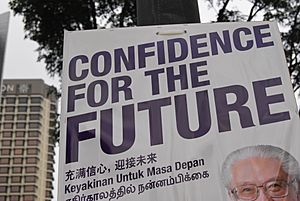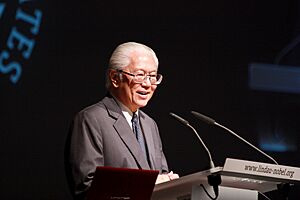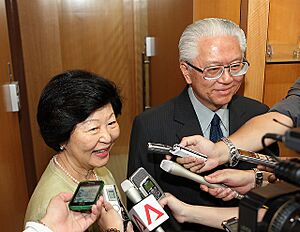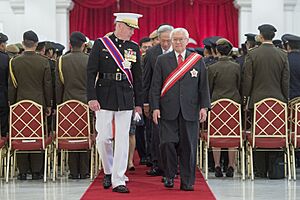Tony Tan facts for kids
Quick facts for kids
Tony Tan
DUT GCB
|
|||||||||||||||||||||||||||||||||||||||||||||||||||||||||||||||||||||||||||
|---|---|---|---|---|---|---|---|---|---|---|---|---|---|---|---|---|---|---|---|---|---|---|---|---|---|---|---|---|---|---|---|---|---|---|---|---|---|---|---|---|---|---|---|---|---|---|---|---|---|---|---|---|---|---|---|---|---|---|---|---|---|---|---|---|---|---|---|---|---|---|---|---|---|---|---|
|
陈庆炎
|
|||||||||||||||||||||||||||||||||||||||||||||||||||||||||||||||||||||||||||

Tan in 2016
|
|||||||||||||||||||||||||||||||||||||||||||||||||||||||||||||||||||||||||||
| 7th President of Singapore | |||||||||||||||||||||||||||||||||||||||||||||||||||||||||||||||||||||||||||
| In office 1 September 2011 – 31 August 2017 |
|||||||||||||||||||||||||||||||||||||||||||||||||||||||||||||||||||||||||||
| Prime Minister | Lee Hsien Loong | ||||||||||||||||||||||||||||||||||||||||||||||||||||||||||||||||||||||||||
| Preceded by | S. R. Nathan | ||||||||||||||||||||||||||||||||||||||||||||||||||||||||||||||||||||||||||
| Succeeded by | Halimah Yacob | ||||||||||||||||||||||||||||||||||||||||||||||||||||||||||||||||||||||||||
| Chairman of the People's Action Party | |||||||||||||||||||||||||||||||||||||||||||||||||||||||||||||||||||||||||||
| In office 1 September 1993 – 3 December 2004 |
|||||||||||||||||||||||||||||||||||||||||||||||||||||||||||||||||||||||||||
| Preceded by | Ong Teng Cheong | ||||||||||||||||||||||||||||||||||||||||||||||||||||||||||||||||||||||||||
| Succeeded by | Lim Boon Heng | ||||||||||||||||||||||||||||||||||||||||||||||||||||||||||||||||||||||||||
|
|||||||||||||||||||||||||||||||||||||||||||||||||||||||||||||||||||||||||||
|
|||||||||||||||||||||||||||||||||||||||||||||||||||||||||||||||||||||||||||
| Personal details | |||||||||||||||||||||||||||||||||||||||||||||||||||||||||||||||||||||||||||
| Born |
Tony Tan Keng Yam
7 February 1940 Singapore, Straits Settlements |
||||||||||||||||||||||||||||||||||||||||||||||||||||||||||||||||||||||||||
| Political party | Independent (2006–present) | ||||||||||||||||||||||||||||||||||||||||||||||||||||||||||||||||||||||||||
| Other political affiliations |
People's Action Party (1979–2006) |
||||||||||||||||||||||||||||||||||||||||||||||||||||||||||||||||||||||||||
| Spouse |
Mary Chee
(m. 1964) |
||||||||||||||||||||||||||||||||||||||||||||||||||||||||||||||||||||||||||
| Children | 4 | ||||||||||||||||||||||||||||||||||||||||||||||||||||||||||||||||||||||||||
| Relatives | Tan Chin Tuan (uncle) | ||||||||||||||||||||||||||||||||||||||||||||||||||||||||||||||||||||||||||
| Alma mater | University of Singapore (BS) Massachusetts Institute of Technology (MS) University of Adelaide (PhD) |
||||||||||||||||||||||||||||||||||||||||||||||||||||||||||||||||||||||||||
| Signature |  |
||||||||||||||||||||||||||||||||||||||||||||||||||||||||||||||||||||||||||
| Chinese name | |||||||||||||||||||||||||||||||||||||||||||||||||||||||||||||||||||||||||||
| Simplified Chinese | 陈庆炎 | ||||||||||||||||||||||||||||||||||||||||||||||||||||||||||||||||||||||||||
| Traditional Chinese | 陳慶炎 | ||||||||||||||||||||||||||||||||||||||||||||||||||||||||||||||||||||||||||
|
|||||||||||||||||||||||||||||||||||||||||||||||||||||||||||||||||||||||||||
Tony Tan Keng Yam (Chinese: 陈庆炎; pinyin: Chén Qìngyán; born 7 February 1940) is a Singaporean banker and politician. He served as the seventh president of Singapore from 2011 to 2017. He won the 2011 presidential election.
Before becoming a politician, Tan was a top manager at OCBC Bank. He started his political career in 1979. He joined the People's Action Party (PAP) and won a seat in Sembawang GRC. Later, he became Deputy Prime Minister of Singapore from 1995 to 2005. After leaving the government in 2005, Tan held important roles. He was deputy chairman of GIC, chairman of the National Research Foundation, and chairman of Singapore Press Holdings (SPH). He left these jobs in 2010 to run for president.
Tan won the 2011 presidential election against three other candidates. He served as president until 2017. He did not run for re-election in 2017. This was because the election was set aside for Malay candidates after a change in the country's rules. He officially retired on 1 September 2017. Halimah Yacob became the next president on 14 September 2017.
Contents
Early Life and Education
Tan was born in Singapore on 7 February 1940. His parents were Tan Seng Hwee and Jessie Lim Neo Swee. He went to St Patrick's School from 1947 to 1956. Then he studied at St Joseph's Institution (SJI) from 1957 to 1958.
In 1962, he earned a Bachelor of Science degree in physics. He graduated with top honors from the University of Singapore, now called the National University of Singapore (NUS). He received a scholarship from the Singapore government for his studies. Later, he got a Master of Science degree in operations research from the Massachusetts Institute of Technology (MIT). He had a scholarship from the Asia Foundation for this.
Tan returned to Singapore and taught physics at NUS for a year. After that, he went to the University of Adelaide for his Doctor of Philosophy degree. He studied applied mathematics there with a research scholarship.
Early Political Career
After his studies, Tan worked as a lecturer in mathematics at NUS. In 1969, he left teaching to join OCBC Bank. He started as a sub-manager and rose to become a general manager. In 1979, he left the bank to start a career in politics.
Tan joined the People's Action Party (PAP). He was elected as a Member of Parliament (MP) for Sembawang GRC in the 1979 by-elections. Later that year, he became a senior minister in the Ministry of Education. On 1 June 1980, during a change in government leaders, Tan was promoted to Minister for Education. This was part of a plan to train new leaders for Singapore. Tan also served as the leader of NUS from 1980 to 1981.
Tan held several important government jobs. He was Minister for Trade and Industry from 1981 to 1986. He also served as Minister for Finance from 1983 to 1985. From 1985 to 1986, he was Minister for Health. During this time, he suggested reducing contributions to a national savings plan (CPF). He was also concerned about how foreign businesses might see worker relations.
In 1981, Tan thought it wasn't the right time to build the Mass Rapid Transit (MRT) train system. He believed that building homes for people should come first. Later, he stopped a policy that gave priority in primary school admission to children of highly educated mothers. This policy had caused public unhappiness.
As Minister for Education from 1985, Tan made big changes to Singapore's education system. He encouraged learning English and speaking two languages. He also focused on teaching good values. He made schools more flexible and gave them more freedom. He also made it easier for students to go to higher education. His achievements included the Gifted Education Programme. He also made English the main language for teaching.
Tan also started the independent schools scheme in 1988. This gave some schools more freedom in hiring staff, managing money, and planning lessons. This was done to improve education standards. It allowed top schools to attract the best teachers and serve as examples for others.
Tan was also known for disagreeing with a shipping industry strike in January 1986. This strike was supported by another minister, Ong Teng Cheong. Tan and other officials were worried about how this strike would affect Singapore's image with foreign investors. Despite the concerns, the strike lasted only two days.
In December 1991, Tan left the government to work in the private sector again. He rejoined OCBC Bank as chairman and chief executive officer from 1992 to 1995. He continued to serve as an MP for Sembawang GRC. In August 1995, he was asked to return to the government. He became Deputy Prime Minister and Minister for Defence. Tan said that Singapore's interests were more important than his personal ones.
In August 2003, Tan became Coordinating Minister for Security and Defence. He continued as Deputy Prime Minister. As an MP, he helped save a historic mosque in his area from being torn down. This mosque, known as the "Last Kampung Mosque in Singapore," became a heritage site. Tan also spoke against building large resorts with entertainment areas. He was worried about the number of people who might develop gambling problems.
Prime Minister Lee Hsien Loong considered Tan as his preferred successor. However, Tan declined the role. Lee praised Tan for his sharp mind and strong decisions. As Deputy Prime Minister, Tan helped shape Singapore's higher education. He was key in creating the Singapore Management University (SMU). He wanted SMU to be different from other universities. He imagined it as a university focused on management, business, and economics.
Tan also led Singapore's "Homefront Security" plan after the September 11 attacks. This plan aimed to coordinate different agencies to deal with new threats. On 19 May 2003, he called the SARS outbreak "Singapore's 9/11." This showed how serious the crisis was. Tan left his roles as Deputy Prime Minister and Coordinating Minister for Security and Defence on 1 September 2005. After this, he became Deputy Chairman and Executive Director of GIC. He also became Chairman of the National Research Foundation and Chairman of SPH.
2011 Presidential Election
On 22 December 2010, Tan announced he would leave his jobs at GIC and SPH. He wanted to run in the 2011 presidential election. His campaign focused on his independence. He said he was willing to have different views from the government. On 7 July 2011, Tan officially entered the race. He won the election with 35.20% of the votes.
On 29 July 2011, Tan addressed claims that his son, Patrick Tan, received special treatment during his national service (NS). He stated that his sons completed their NS duties fully. He also said he never interfered in their postings. Patrick explained that he was allowed to pause his NS in 1988 for pre-medical studies at Harvard University. He later pursued an MD–PhD at Stanford University. The Ministry of Defence (MINDEF) confirmed that before 1992, it was normal to allow NS disruptions for overseas medical studies. They also said longer disruptions were given for U.S. universities. Defence Minister Ng Eng Hen confirmed in parliament that Patrick did not receive any special treatment.
Campaign for President
Tan described himself as "Tested, Trusted, True." He stressed that his wide experience would help Singapore through financial challenges. On 7 August 2011, the Federation of Tan Clan Associations, with 10,000 members, supported his bid. On 11 August, the Singapore Malay Chamber of Commerce and Industry (SMCCI) also supported him. They noted his long service to the Malay-Muslim community. He promised to focus on social harmony.
By 13 August, leaders from 19 unions, representing 128,000 members, supported him. The next day, Chinese clan associations and the Chinese Chamber of Commerce also showed support. On 16 August, four unions from the construction and real estate sectors, with over 50,000 members, endorsed Tan. Support also came from nine Teochew clan associations.
On 17 August, leaders from transport, marine engineering, and info-comm sectors, representing 112,000 workers, declared their support. On Nomination Day, Tan showed his campaign symbol: a pair of black glasses. This reflected the glasses he always wore. The symbol was on campaign items like caps and posters. On 18 August, SMCCI became the first Malay group to officially support Tan.
On 22 August, 46 trade unions publicly supported Tan. They represented over 75% of the labor movement. They mentioned his broad experience in finance, economics, and media. Tan thanked them and promised to serve all Singaporeans.
Election Results
Tan was elected President of Singapore on 27 August 2011. This happened after a vote recount between him and another candidate, Tan Cheng Bock. He won by a small number of votes. His win was seen as a challenge for Prime Minister Lee, who had supported him. This was the first presidential election in 18 years. The presidency is a ceremonial role, meaning it's not involved in daily politics. Tan said after the results, "I plan to work tirelessly for all Singaporeans, no matter their political views. The president is above politics."
Public Reaction
On 17 August 2011, some people booed Tan during his Nomination Day speech. According to The Straits Times, these jeers came from supporters of another candidate. At a press conference, Tan said that while different views are expected, it was disappointing when people would not listen. He hoped Singaporeans would listen to all candidates. He said, "I don't think that jeering or heckling is the right way to go about the campaign."
During the first presidential candidate broadcast on 18 August 2011, Tan did not make promises. Instead, he explained the president's role. Speaking in English, Chinese, and Malay, he said, "Some people argue that the president must take a public stand on current issues. I hear and share the concerns of Singaporeans. But policies are debated in parliament and carried out by the government." He added that the president is not meant to oppose the government.
Presidency (2011–2017)
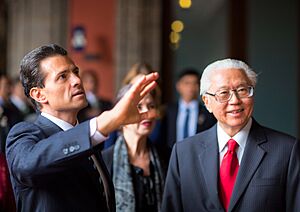
Tan became the seventh president of Singapore on 27 August 2011. He took over from S. R. Nathan. In his first speech to the 12th Parliament, Tan said Singapore's success should include shared values. He stressed the importance of building a more caring society. In 2012, under his leadership, the President's Challenge expanded. It began to promote volunteering and social businesses, not just fundraising.
On 26 July 2013, Tan met with Prime Minister Shinzo Abe during his visit to Singapore. In November, Tan focused on encouraging more active community involvement. He said Singapore needed to build its "social reserves." He used the expanded President's Challenge as an example of this effort.
On 4 April 2014, Tan, as patron of the Singapore Red Cross, gave S$7.5 million in donations. This money was for recovery efforts in areas of the Philippines affected by Typhoon Haiyan. On 8 May, he visited Switzerland. He met with Swiss President Didier Burkhalter to strengthen ties. On 24 October, during a visit to the United Kingdom, Tan visited Lloyd's of London. He also attended a state banquet hosted by Queen Elizabeth II. He met members of the British royal family.
On 18 April 2015, Tan opened the Lee Kong Chian Natural History Museum. This is Singapore's first natural history museum. During his visit to China on 3 July, he met with Premier Li Keqiang. They aimed to strengthen ties between the two countries. On 15 July, he opened the Sisters' Islands Marine Park Public Gallery. This showcased Singapore's sea life. In August, he exchanged messages with President Park Geun-hye. This was to celebrate 40 years of diplomatic relations. On 6 November, Tan met with Chinese President Xi Jinping. They agreed to improve their trade agreement.
On 26 May 2016, Tan opened the Singapore Pavilion at the Architecture Biennale in Venice. During a visit to Tokyo on 30 November, he spoke about the friendship between Singapore and Japan. On 8 November, Tan announced he would not run in the 2017 presidential election. This election was reserved for Malay candidates. He finished his six-year term on 31 August 2017. A farewell event was held for him at the Istana. Halimah Yacob became president after him.
Later Life
After leaving office in 2017, Tan continued to serve Singapore. On 21 November 2017, GIC announced that Tan would become a Director and Special Advisor. In a Tatler interview on 23 November 2017, he talked about how important social media had become. He used social media during his presidency to connect with Singaporeans. He sometimes replied to comments. He mentioned the 2013 Little India riot as a time when he realized how urgent online communication was. Even after leaving office, Tan stayed involved in public life.
On 12 March 2024, Tan launched his book, Tony Tan Keng Yam: My Political Journey. He wrote it with former journalist Leslie Koh. The book tells the story of Tan's life and public service. Prime Minister Lee Hsien Loong spoke at the launch.
Personal Life
Tan's grandfather, Tan Cheng Siong, was a manager at Overseas Chinese Bank. This bank later became part of OCBC Bank. His uncle, Tan Chin Tuan, was chairman of OCBC Bank. On his mother's side, Tan is a direct descendant of the kind person Tan Kim Seng.
In 1959, while studying physics at the University of Malaya (now NUS), Tan met Mary Chee Bee Kiang. They fell in love and married five years later in 1964. They have five children: Peter, Sharon, Patricia, Patrick, and Philip. Tan's son-in-law, Simon Chesterman, is a leader at NUS.
Awards and Honours
Awards
In 2005, NUS gave Tan the Eminent Alumni Award. This was for his important role in shaping Singapore's universities. In 2010, he received the first Distinguished Australian Alumnus Award. This honored his career and contributions to society. The Foreign Policy Association gave him a medal in 2011 for his excellent leadership.
On 22 October 2014, the Royal Society gave him the King Charles II Medal. This was for his efforts in promoting science education and research in Singapore. In 2017, Tan received the "Key to the City" from Prague, Czech Republic, during his visit.
Honours
Tan has received many honours for his contributions. On 17 June 2014, his former university, the University of Adelaide, gave him an honorary doctorate. This was for his achievements as a leader in government and business. The Singapore Medical Association gave him its highest honour in 2015. This recognized his support for medicine. On 24 July 2018, NTU honored him with an honorary Doctor of Letters degree. On 26 July 2022, SMU gave him an honorary Doctor of Laws degree. This recognized his key role in creating the university.
National
Foreign
 United Kingdom
United Kingdom
 Knight Grand Cross of the Order of the Bath (GCB; 2014)
Knight Grand Cross of the Order of the Bath (GCB; 2014)
See also
 In Spanish: Tony Tan Keng Yam para niños
In Spanish: Tony Tan Keng Yam para niños


